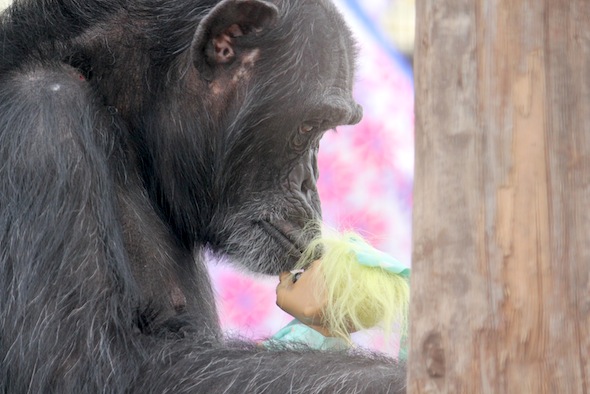This is the first of a series of guest blogger posts from researchers that work with free-living apes. Maureen McCarthy graduated from the Chimpanzee and Human Communication Institute and is currently a PhD candidate at the University of Southern California. She is doing research with chimpanzees in Uganda and has a regular featured blog on Scientific American’s blog. Here’s her most recent entry that mentions Foxie:
—
Their chorus of pant hoots gave them away in dramatic fashion. The chimpanzees we’d been looking for were nearby, and we knew exactly where to find them. Though farmland and trees blocked our view, we could hear that the chimpanzees had arrived at a particular fig tree laden with ripe fruits. As ripe fruit specialists, chimpanzees seek out fruiting figs like this Ficus exasperata. On a good day, we can use our knowledge of when these figs are ripening to help us find the chimpanzees.
We took a circuitous route through the gardens to a grassy hilltop with a clear, albeit distant, view of the Ficus. I dropped my backpack and pulled out my binoculars. I began to scan the tree in an attempt to identify the large dark figures foraging. I could make out the silhouettes of at least seven or eight chimpanzees, all foraging on figs or seated in the huge tree.
Chimpanzees feed in a Ficus exasperata tree. Photo © Jack Lester.
After observing their foraging for a few peaceful moments, I heard a jarring but familiar sound. A man working in a garden nearby shouted at the chimpanzees. Though the tree was in an isolated area of grassland several dozen meters from where he worked, he was clearly uncomfortable with their presence. A few threatening shouts were enough to convince the chimpanzees it was best to cut short their breakfast. They descended quickly from the fig. I now counted twelve chimpanzees as they walked in a single file line back across the grassland and to a small patch of forest nearby. As we watched them go, field assistant Nick commented that he felt sorry for the chimps.
At times like these, I am reminded of one of the most recurrent lessons from my research thus far: chimpanzees are surprisingly resilient. They may have waited until later to forage, or perhaps they found another source of nutrition (which, unfortunately, may have involved risky crop-raiding). However, as long as no one hunted them or set a mantrap to ensnare them, as is sometimes the case, they probably found something to eat and survived another day. Despite the rapid rate of forest degradation in their habitat, they have persisted. They continue to forage, reproduce, and tend to the complex political matters of chimpanzee life, even if these behaviors must be modified somewhat to fit a drastically altered environment.
I was again reminded of chimpanzee resilience when, on a recent visit to my mother’s home, I opened an old box to find my childhood collection of troll dolls. After a moment’s consideration, I decided to send them to a chimpanzee named Foxie. Foxie is a resident of Chimpanzee Sanctuary Northwest (CSNW), a sanctuary in Cle Elum, Washington that serves as home to seven chimpanzees. The “Cle Elum Seven,” as they are known, have lived in biomedical laboratories for most of their lives. They were involved in invasive hepatitis vaccine research and used for laboratory breeding. Foxie gave birth to five infants, but was forced to give them all up, just like so many other breeding female chimpanzees in laboratories. Perhaps as a fulfillment of the maternal behaviors she was never able to express, Foxie can now usually be found carrying a troll or other doll with her.
Foxie cares for a troll doll.
The caregivers who know Foxie and the other members of the Cle Elum Seven can attest to this adaptability. All seven have displayed drastic changes in both behavior and physical appearance since arriving at CSNW several years ago. The shift from a windowless laboratory basement to a spacious sanctuary with dedicated caregivers and outdoor access has—not surprisingly—had an unambiguously positive effect on them.
Why might chimpanzees be so adaptable to change? It may have aided the survival of their ancestors–and ours. For example, many primates regularly face drastic seasonal changes in rainfall, temperature, and food availability. Some primates have specialized adaptations that help them survive under harshly changing seasonal conditions. For chimpanzees, a learned knowledge of the fruit tree locations, even during periods of low fruit availability, is critical. Chimpanzees acquire this knowledge over a prolonged period of development, with high reliance on their mothers until full weaning at age 5, followed by juvenile and sub-adulthood learning periods lasting until age 15. A high degree of neural plasticity facilitates this learning ability. In humans, an especially high degree of plasticity may aid our strong reliance on learning. Plasticity may also play a key role in what we call resilience, enabling both humans and our chimpanzee kin to roll with the punches during trying times. For chimpanzees today, this may mean finding a new fruit tree when one due to ripen has been felled, or basking in the sun for the first time after decades inside a laboratory.
This post was originally published at Scientific American.






